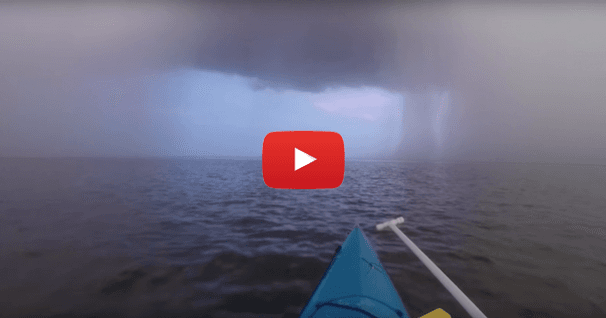Compass Basics - The Marine Compass

Looking at the compass from the cockpit will tell you which way the boat is pointing, not necessarily what direction it is going. You could be drifting NE while your bow is pointing slightly ENE. That’s all part of "navigating" - for now, let’s concentrate on that compass on your deck.
By physical description, a "marine" compass is the dome-shaped bulb compass used by many boaters with a dial that rotates on a pivot (a land compass is usually circular and flat like a pocket watch, and sometimes attached to a flat base. It usually has a N/S needle that rotates freely). Most kayakers attach these units to the fore deck of a kayak either permanently or with the use of a bungee cord, strap or other tie-down mechanism.
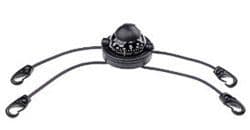
A marine compass is oriented so the N-S line of the compass runs through the pivot point on the compass dial and an index mark on the compass’s base. This is called a "lubber’s line." This line needs to be aligned along the centerline of the craft: bow/north; stern/south. Take the time to orient the N-S line because a slight offset of only a few degrees will affect all your readings.
The Compass Rose & Compass Variation
The marine compass is used in conjunction with the compass rose printed on most nautical charts. Within the rose is vital information that directly translates to the use of that compass.
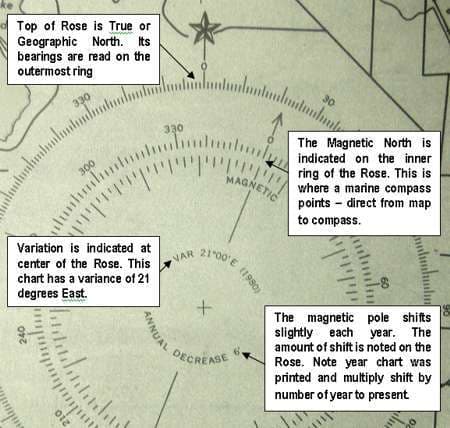
50 years of lightweight, maneuverable, high-performing kayaks.
Check out this interview with Tom Keane, Eddyline Kayaks Co-Owner, on their journey!
The outer ring on the compass rose represents true or geographic north (see the last article for details on how a compass works). On this outer ring, true north is 0 degrees/360 degrees. It is printed so that true North is at the top of the map. Since there is a variation from true North to where the compass needle actually points – called the Magnetic North – the compass needle or dial does not actually point to the true North Pole (except in very few places on the globe).
The next, inner ring on a nautical compass rose is a second ring of 360 degrees but it is turned slightly to represent the amount of magnetic variation in that particular area covered by the chart. That amount of variation is printed in the center of the rose. If you compare it to the outer ring you will see that “North” on the second ring has been rotated east or west the number of degrees of variation as indicated on the rose. If, for example, the variation for the area, as shown on the rose is 12 degrees East, the North point on the second/inner ring (magnetic north) will be 12 degrees further to the right (east) than the actual True North point.
Here’s the simple beauty of using a compass with nautical charts. Charts are designed to be read using magnetic bearings. The inner ring allows you to determine all the magnetic bearings of landmarks and such so you can read directly from map to compass – and back – without having to make any adjustments or do any math.
Sweet, eh? If you determine, from the map that a point of land is 75 degrees (based on the inner ring) from where you are, that’s the bearing you can use – without making any compass adjustment for variation or true north.
However, it’s not always that simple; there is wind, current, variations in paddling that all add a bias to that direct route. If you paddle for a half hour and take another reading you may find that the target destination is now 78 degrees. That means you’ve drifted east of your course a bit. You will have to readjust to this new heading. If you stay on the initial 75 degrees heading, but have been drifting, you will end up further down the shore that you intended.
Compass Deviation
There is another consideration when using a compass. How do you know the compass is pointing at magnetic north and not at your hatchet packed away below deck? You may have to deal with "compass deviation." Because the compass dial is 360 degrees, it’s easy to determine the reciprocal or opposite bearing. The reciprocal of North is 180 degrees (one half of the full, 360 degrees circle) or South. The reciprocal of 110 (about ESE) is 290 degrees or approximately WNW). To check to see if the compass has any deviation, orient it on a well-defined line between two objects. Take a bearing on an obvious landmark on the line in front of you ("toward" bearing), and then swing around and take one in the opposite direction immediately behind you ("back"/"away" bearing). That second bearing should be the reciprocal, or 180 degrees, from the first. If it’s off several degrees check to see if your load needs to be shifted. If not, you may just have to adjust your reading.
Let’s say you are heading out on a bearing of 280 degrees, the reciprocal or "back" bearing should be 180 degrees less, or 100 degrees. Instead it reads 88 degrees. You’ve got a compass deviation of 12 degrees. You need to adjust your reading, take an average bearing that compensates for this deviation. That means your "back" bearing! is 6 degrees too low; your "toward" bearing is too high. You therefore need to add half of that compass deviation of 12 degrees to your away bearing and subtract it from your "toward" bearing. Unfortunately this deviation can change. You need to do it often if you fear your compass is off.
Tips for Determining Course Bearing
An easy and accurate way of determining what bearing you must take to reach a desired destination is to mark that course line on a piece of tracing paper and then transferring that line to the compass rose:
1. Determine the course you want to take. Mark it on your chart (A – B on illustration #1).
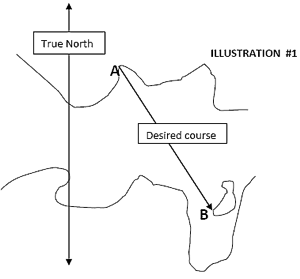
2. Using either tracing paper or a sheet of acetate, transfer the True N-S line and course line to the sheet.
(Illustration #2)
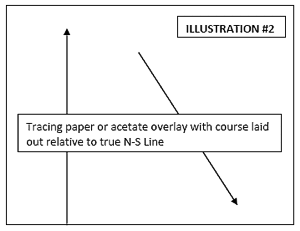
3. Take the overlay with your course and the True N-S line and lay it over the top of the Compass Rose that is printed on the chart.
(Illustration #3).
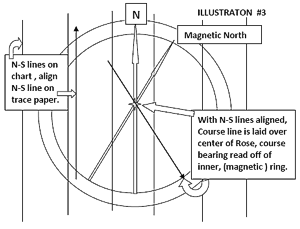
4. Make sure that your True N-S line is parallel to those on the chart; then move your overlay around until the course line goes through the center of the rose. Keeping it on center, maneuver the course line until the tip of it intersects the inner ring of the Rose (the inner ring is the magnetic bearing ring. Illustration #3).
5. The bearing indicated on inner ring is the compass bearing to follow to reach your destination.
Hedging your Bearing
When in limited visibility, or because of the effects of current, some kayakers prefer to deliberately head slightly wide, to the right or the left of their mark when making a long crossing. Upon reaching their destination area, they know they must then travel left or right to hit the mark dead on. All things being equal, a slight shift in the desired bearing can give you that "side" advantage.
Here’s a simple scenario to illustrate this last paragraph. You determine that the 45 degrees bearing will put you on the eastern point of a headland you are seeking. Drift is going to be minimal but you want to add some insurance to your course so you deliberately steer to a cove slightly to the left (west) of 45 degrees. When you reach the far shore, even in fog or other limited visibility, you are reasonably sure that your target is a short distance to the right (east).
So Much More…
This is only the beginning of all that can be achieved with the compass and what needs to be learned to develop sound navigational skills. An excellent source of information, even 20 years after it was published is "Fundamentals of Kayak Navigation" by David Burch.
I have not seen these, but two other books to consider include: "Sea Kayak Navigation Simplified" by Lee Moyer and "Simple Kayak Navigation" by Ray Killen.
Tom Watson is an avid sea kayaker and freelance writer.
His latest book, "Kids Gone Paddlin" is available on Amazon.com.
He is also the author of "How to Think Like A Survivor"
Related Articles
Antonio De La Rosa, a 50 year old Spaniard, left the San Francisco Harbor on June 9th to start the 2,900…
Even if you do your research and check the weather before heading out, sooner or later every kayak…
When a situation occurs while paddling in a group, conditions don't stop. Learn some pointers on how to…
Dungeness Spit from above, with the New Dungeness Lighthouse in the distance Dungeness…


